The Basic Structure of the Atom: Atomic Structure
Atomic Structure: All atoms consist of a nucleus which contains two types of subatomic particles – protons and neutrons. The nucleus is surrounded by a cloud of electrons at varying energy levels. These subatomic particles are composed of even smaller particles known as quarks which came together after the Big Bang around 13.7 million years ago.
Review – Models of Atom before Teaching Atomic Structure
-
Place the atomic models in order of their atomic discoveries. Starting with the earliest.
- Electron cloud model
- Plum pudding model
- Nuclear model
- Solid sphere model
- Quantum model
-
Decide whether the following statements are true or false. If the statement is correct, then leave it as is. If the statement is false, correct it to make it true.
- Thomson discovered the neutron.
- Atoms primarily consist of empty space.
- Rutherford used alpha particles in his experiments
- Protons are able to change energy levels.
- Chadwick discovered that electrons prevent the nucleus from breaking apart.
-
Choose one model from the following list and describe one of its key findings.
- Electron cloud model
- Plum pudding model
- Nuclear model
- Solid sphere model
- Quantum model
The Nucleus
The nucleus is held together by the “strong force,” which binds the quarks together. This force found in the nucleus has sufficient strength to overcome the repulsive electrical force which aims to push like charges apart. Because this binding force varies from atom to atom, sometimes the nucleus decays into other elements as it breaks apart.
Charged Subatomic Particles
Protons and electrons are oppositely charged giving the atom an overall (net) charge of zero. The table below shows the charge and relative mass of each of the three particles found in the atom (the neutron is used as a point of comparison to find the relative mass of protons and electrons).
[su_table responsive=”yes” alternate=”no” fixed=”yes”]
| Charge | Relative Mass | |
| Proton | Positive | 0.9986 |
| Neutron | No charge (neutral) | 1 |
| Electron | Negative | 0.0005439 |
[/su_table]
The Mass of an Atom:
The majority of the mass of an atom is found in its nucleus. The protons and neutrons are approximately the same mass (with the proton being is slightly less), known as one atomic mass unit (AMU) or one Dalton. Electrons are much smaller than protons and neutrons, so much so, that they do not contribute much to the mass of an atom.
Atomic Number:
The atomic number tells us how many protons it has. It is denoted by the letter ‘Z’. This number can be found under the entry for each element on the periodic table.
Mass Number:
The mass number provides information about the number of protons and neutrons contained in the atoms nucleus. It is denoted by the letter ‘A’. To find the number of neutrons in any given element, the atomic number (or number of protons) is subtracted from the mass number.
An example:
A lithium atom has the atomic number (Z) of 3, and the atomic mass (A) of 6.94 (round it up to 7!). Therefore lithium contains three protons (found from Z), and three electrons (as the number of protons must be equal to the number of electrons in order for the atom to be neutral). Lithium also contains four neutrons (7 – 3 = 4).
Atomic Structure Practice:
Use the periodic table from your guided notes (page 3) to complete the table below:
[su_table responsive=”yes” alternate=”no” fixed=”yes”]
| Number of protons | Number of electrons | Number of neutrons |
| Hydrogen | 1 | |
| Fluorine | 9 | 10 |
| Calcium | 20 | 20 |
| Iodine | 53 | |
| Gold | 79 | 79 |
[/su_table]
Complete the information chart below comparing atomic number with atomic mass.
Atomic Structure Quiz
-
Draw and label a diagram of a helium atom.
-
Give the number of electrons in the following:
- Boron
- Sulfur
- Copper
-
Give the number of neutrons in the following:
Show your work.
- Potassium
- Silver
- Bromine
Homework Atomic Structure
-
Use your periodic table to identify each of the following elements based on their atomic numbers:
- 4
- 13
- 36
- 79
- 23
-
Use your periodic table to identify the following elements based on the number of electrons given below.
- 8
- 12
- 17
- 47
- 80
-
Give the number of neutrons for the following:
Show your work.
- Vanadium
- Platinum
- Radium
- Xenon
- Lead
Here is your Free Content for this Lesson on Atomic Structure!
Atomic Structure – PDFs
- 1-4 Additional Resources – Atomic Structure (FREE)
- 1-4 Bell Ringer SE – Atomic Structure (FREE)
- 1-4 Bell Ringer Teacher Edition – (MEMBERS ONLY)
- 1-4 Doodle Notes – Atomic Structure (FREE)
- 1-4 Exit Quiz SE – Atomic Structure (FREE)
- 1-4 Exit Quiz Teacher Edition – (MEMBERS ONLY)
- 1-4 Guided Notes SE – Atomic Structure (FREE)
- 1-4 Guided Notes Teacher Edition – (MEMBERS ONLY)
- 1-4 Homework Questions SE – Atomic Structure (FREE)
- 1-4 Homework Questions Teacher Edition – (MEMBERS ONLY)
- 1-4 Lesson Plan – Atomic Structure (FREE)
- 1-4 Slide Show – Atomic Structure (FREE)
- 1-4 Vocabulary Worksheet SE – Atomic Structure (FREE)
- 1-4 Vocabulary Worksheet Teacher Edition – (MEMBERS ONLY)
Atomic Structure – Word Docs & PowerPoints
To gain access to our editable content Join the iTeachly Chemistry Teacher Community!
Here you will find hundreds of lessons, a community of teachers for support, and materials that are always up to date with the latest standards.
Want access to all of our Chemistry Lessons?
Simply click the image below to GET ALL OF OUR LESSONS!
Don’t Forget to Pin this Lesson on the Atomic Structure…
This lesson is from…






